Give this eating approach a try to get lean fast. I’ll let you in on a little secret: Paleo dietsOpens in a new Window. can work. Low carb diets can work. Flexible diets can work. Intermittent fasting can work. High carb diets can work. Just eating food can also work. Juicing… meh, stick with one of the above. I’m not being facetious here. The point is, most diets can work. When implemented with consistency, that is. But by that same token, they can fail miserably if you’re not goal-focused and apply them slapdash in between binges.

First, some house keeping: the key to fat loss Opens in a new Window. is being in a calorie deficit. Simple, right? Not exactly. Men in particular are prone to unwittingly being in a calorie surplus and then wondering why they don’t have shredded, six-pack abs. Monitor your intake.
Rule one
Now on to actually getting shredded, six-pack absOpens in a new Window.. If you’re looking to maximize your fat loss while holding on to as much muscle as possible (beach body, anyone?) you should try out my favorite diet system. It’s called carb cycling. And here’s how it can work for you.
Carb Cycling
Carb cyclingOpens in a new Window. is one of those terms that gets as many articles written promoting it as it does deriding it, although they are usually from people who either don’t fully understand it or aren’t using it as intended. It’s not a new thing. But it’s a misunderstood concept to the point that using it correctly is very new indeed.

So, how is it done? Well, the basic principle of carb cycling is simple. Over the course of a week you have days with high, medium and low carbohydrate intake. That sounds easy, and it is, but you have to coincide your higher-carb days with heavier gym sessions and low-carb days with either rest days or low intensity opens in a new Window. training. Whatever the day, you also require a high protein intake to help muscle growth. It’s this cycling of carbs that leads to fat loss and muscle growth. As much as you’re cycling your carbs, you are also cycling your fat intake. It should be low when your carb intake is at its highest, and high on days when your carb intake is low. All of this carb cycling gives your body a number of physical and biological benefits, namely:
– Improved insulin sensitivity
– Improved metabolism
– Improved muscle gain
– Improved fat burning

Why It Works
Despite what we so often read, carbs aren’t necessarily kryptonite to the body you want. It’s true that there are no essential carbohydrates, unlike essential fats and amino acids, but they do help to boost metabolism (and of course they tend to be delicious). If your timing is off, however, and calories are too high, carbs can easily be stored as fat. But not any longer. We’re going to use them to our advantage. It might sound like carb cycling is purely focused on what you eat, which it is to a point, but it’s what’s happening to your body internally that gives you the edge. High-carb days are all about refueling your muscles’ glycogen levels and flooding your body with insulin. This process has anti-catabolic efforts, reducing muscle loss. Insulin inhibits muscle breakdown, which is perfect for those days when you’re doing your toughest, most intense workouts on high carb days. On moderate (or medium) carb intake days, you are giving your muscles just enough carbs to maintain their glycogen stores, but creating a biological environment for improved insulin sensitivity, and consequently, fat loss.

For days when you’re eating food with low carbohydrate properties, this is when you’re going to be in the lowest calorie situation too. By only doing low intensityOpens in a new Window. workouts, or having a complete rest day, in a way, you are fooling your body into burning fat at an accelerated rate by keeping the insulin levels low. When it comes to fat loss, this is the part of the process where it really begins to work.
But what do i eat?
Good question. These are examples only and without the macro breakdown, the practical application is limited, but they show how the principles can be implemented. Tuck in.
Example high-carb meals
Breakfast: Oatmeal with whey protein and almonds
Lunch: Sweet potato with chicken and broccoli
Dinner: Quinoa with salmon, pine nuts and asparagus
Example medium-carb meals
Breakfast: Rye bread with scrambled eggs, spinach
Lunch: Brown rice with chicken and broccoli
Dinner: Avocado and prawns with rocket and tomato

Example low-carb meals
Breakfast: Smoked salmon with scrambled eggs, avocado and asparagus
Lunch: Chicken and cashew stir fry with peppers, broccoli and spring onion
Dinner: Tuna with avocado and green beans
Don’t think that healthy food should be boring! Use these healthy flavoring options to keep your taste buds happy and your willpower high.
Lemon, Lime, Fresh or dry herbs, Chili, Garlic, Ginger, Soy sauce, Pepper, Curry powder
What else do i need to know?
If you think carb cycling might be something you want to try, there are a couple of other things you need to know. Carb cycling works well for both fat loss and muscle gain. For fat loss as a primary goal, you should be in an overall calorie deficit. For muscle gain as a primary goal, you should be in a calorie surplus. As I touched upon earlier, keep your protein intake high; it’s essential for maintaining muscle in a calorie deficit.
Two simple rules
Don’t be afraid of fats, but use them wisely. Eating food with higher fat content on your non-training days is ideal. Follow these two simple rules and you’ll see the benefit of carb cycling in no time.
